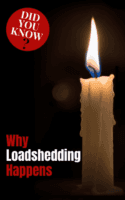Claire, an American student visiting friends in South Africa, couldn’t understand what they meant when they said, “Did you check the loadshedding schedule? I think we’re off at 2pm, better charge the laptop.”
“What is loadshedding?” Claire asked, confused.
Loadshedding went from a temporary solution to a part of our daily lives. It is even considered a word in the dictionary:
Loadshedding (noun): action to reduce the load on something, especially the interruption of an electricity supply to avoid excessive load on the generating plant.
Now Claire had a valid point, why do we need load shedding and what exactly is it? Let’s take a look…
What is loadshedding and why is it necessary?
In an electricity system, generating capacity and load must be balanced. If the demand for electricity becomes too high, generating equipment becomes overloaded and could break down. Loadshedding prevents the overloading of equipment by removing or shedding, some of the load.
The demand for electricity has increased drastically as the years pass. Power systems, therefore, require constant management of supply to meet those high demands. The older power stations and infrastructure are being used to full capacity. Necessary maintenance of plant and infrastructure is carefully scheduled to limit compromising supply capacity during periods of high demand.
People often confuse local outages with loadshedding. Local outages only occur when there is either a technical fault in the transmission or when electrical equipment has been tampered with such as theft of cables.
Loadshedding is done to protect the electricity power system from a total blackout. A blackout happens when there is too much demand for electricity but not enough supply.
When a blackout takes place, countries are able to tap into a power system from a neighbour which can take a few hours or days, but we have to rely on ourselves to start the system from scratch – energising one power plant at a time and one section of the country at a time. It could take up to two weeks to restore full power, which would have a severe impact on our country. Loadshedding is a way of protecting the country from such an event.
What do the four stages mean:
Stage 1: Eskom needs to shed 1000MW to keep the national grid stable. It is the least disruptive of the schedules. Your area is likely to be hit by 2.5-hour blackouts once every second day. Load shedding won’t take place overnight or on Sundays.
Stage 2: Eskom needs to shed 2000MW to keep the national grid stable. It involves double the amount of load shedding planned in Stage 1. Your area is likely to be hit by 2.5-hour blackouts once a day, but likewise with load shedding won’t take place overnight or on Sundays.
Stage 3: Eskom needs to shed up to 4000MW to keep the national grid stable. This stage involves double the amount of loadshedding planned in Stage 2. The loadshedding will take place 24 hours per day and will also happen on Sundays.
Stage 4: Eskom needs to shed more than 4000MW to keep the national grid from collapsing. This is the worst stage. It is unscheduled cuts. This means your area can be hit at any time without any warning. Stage 4 loadshedding is the final option for Eskom to prevent a national blackout.
How to prevent loadshedding:
There are many ways to save electricity and thus preventing the need for loadshedding:
● Turn off the lights. You should never leave the lights on during the day. If you’re not in the room, at night, then switch that room’s light off.
● Replace your lightbulbs with LED lightbulbs, as they save energy.
● Where possible, use your microwave instead of the stove.
● Don’t use the dishwasher, rather do the dishes by hand.
● Defrost your freezer regularly as ice build-up prevents the freezer from working effectively.
● Don’t charge your phone overnight.
What to do during loadshedding:
● Install a solar geyser, get solar lamps to put outside in the garden and take inside when the lights are out. There is also a solar cellphone charger available.
● Make use of gas stoves. With gas stoves, you don’t need electricity when cooking food or boiling water for electricity.
● Use empty plastic cool drink bottles and fill them with water and place in your deep freeze. If the power is out for a long time, you can take them out and put them in your fridge to keep food cold until the power comes back on. It also will create extra freezing in the deep freeze to keep your meats from thawing.
● Get battery-operated lights. You can get torches and other battery-operated lights to keep around the house when the power goes off. It’s less dangerous than using just candles.
● Get a generator. This is quite expensive, but depending on your needs, it comes in handy.
● Make sure you have car chargers for your cell phone and laptop.
***
Did you know that wind can actually generate electricity? Click here for more.
Tell us: How do you think we can solve the electricity crisis in South Africa?


